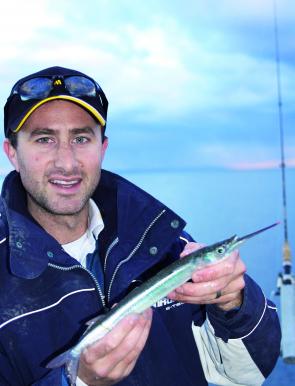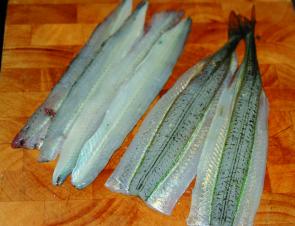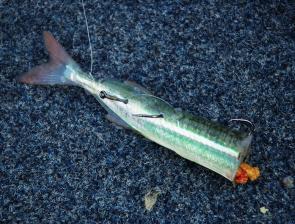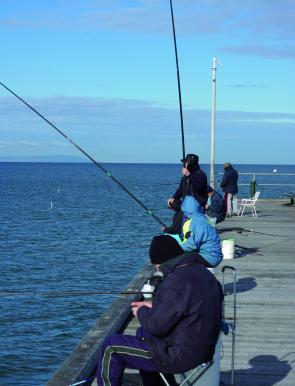What could be better than spending a few hours fishing for a species that is abundant, relatively easy to catch and offers some of the best bait and food going around? What’s more, garfish are one of the best species for teaching young anglers some of the finer points of fishing. I love to fish for garfish, because whether it’s for bait or food, they are always fun.
Being an abundant schooling species, garfish can be found in many locations, from estuary systems and bays to ocean waters. It doesn’t matter if you have a boat or are land-based, as they are regularly found over shallow warm areas that offer cover in the form of weed and rocks. These areas also provide plenty of food and cover for the garfish, which is important as they rate very highly on the menu for a whole host of predatory species.
Garfish spend a lot of their time swimming higher in the water column, feeding on plankton and other small food sources. They have a keen sense of smell and this is what makes them such a great species to target. Using berley they can be brought in from long distances, even in deeper water, in their endless quest an easy meal.
To catch garfish in numbers it is usually best to use berley. They respond well to tuna oil, which has a strong smell. It’s also very important to be aware of the fact that they are a relatively small fish and only have a small mouth. It’s imperative that you use a very fine berley source that will attract them, but not feed them too much. You don’t want them full by the time they reach your bait.
Berleying can be as simple as placing a piece of rag soaked in tuna oil in the water or berley pot. This will allow the oil to slowly wash out of the rag, creating a surface slick but no food source.
My favourite berley option for garfish is to use either a pellet-based berley that is soaked in tuna oil, then placed in a fine mesh bag or berley pot and hung in the water. This creates the oil slick from the tuna oil, and as the pellets slowly break down they put out a very fine misty trail that carries a long way as it slowly sinks through the water column, effectively covering a lot more water.
The other addition to the berley system is a fine powdery mixture that can be as basic as some breadcrumbs mixed with tuna oil or, as I prefer, the Stimulate Ground Berley. This is filled with oil, which allows you to get a small portion, squeeze it into a small ball and throw it near your bait, this breaks up on hitting the water and helps to attract garfish directly to your bait.
Other good berley sources are a bit of bread soaked in water and then mashed up. Just make sure it’s completely crushed into a fine mix, as larger pieces will float away and can take the fish with them on the tide or wind.
One of the many great things about fishing for garfish is that it doesn’t require expensive outfits to catch them. It can be as simple as a handline or preferably a light spinning or nibble tip outfit.
My own set ups consist of 7’ nibble tip rods matched to 2000 sized reels. Basically these are the outfits I use for whiting fishing. The reels are loaded with 3kg monofilament and to this we attach our rigs
Other than the rod, reel and line you will need some size 10-12 longshank hooks, splitshot and floats, which can be the standard quill, bobby cork or pencil types.
As for the actual rigs, most anglers choose to use a float rig because it is the ideal setup for gars in nearly every situation as it suspends the bait higher in the water where the gars swim
Whether you use a running or a fixed float is really up to you. Most anglers choose a simple quill float which is a fixed rig with a small piece of tube holding the bait at whatever depth you choose to fish.
Another float rig, and the one I like to use, is what’s known as a running float rig. This rig allows you to adjust the depth of the bait being used, which is really handy if fishing with shorter rods or wanting to fish your bait quite deep. You simply have a small rubber or silicone stopper on the line which can easily be wound through the guides and onto the reel if need be. Then when the rig hits the water the bait will sink until the float stopper gets to the float.
Asides from what float rig you use, the most important thing of all is to make sure the float is set correctly in the water. You need to make sure that only the stem (bright orange or yellow tip) of the float is above the water. This is especially important in floats with an actual body such as a pencil float. If the body of the float isn’t below the water when a garfish takes the bait there will be a lot of resistance on the float, in which case you will find you will get lots of bites with the float half going under before the fish rejects the bait.
To get your float sitting correctly you need to get hold of some good soft splitshot and add them along the line from about 30cm to 1m above the hook. Put them on the line then put the rig in the water to see how it sits. If it needs to sit lower, keep adding weight and checking until it’s right – by doing this you will catch far more fish.
Other rig options are a single hook on the line with a small piece of splitshot 30cm above the hook, cast it out and allow it to slowly sink through the water column until the garfish pick it up and swim off with it. Fishing with a paternoster rig on the bottom can also be a great way to find bigger garfish, especially at Frankston, Mordialloc and Mornington piers.
There are a wide variety of baits to choose from, ranging from flathead and garfish flesh to bread or dough. Most anglers would agree, however, that garfish find it hard to go past maggots or those small white baitfish called ‘silverfish’.
When chasing gars, using a float offers several advantages. One is that it suspends the bait in the right area and allows a visual indication of your bait being eaten, which is handy because garfish don’t bite like normal fish and can be difficult to hook. The key to float fishing is timing, and with practice you soon get the hang of allowing the float to disappear for a second or two before striking. When it is time to strike, a small flick of the rod is all that is required to set the hook. Even if you miss the gar, the float won’t move far and you will often have a fish back at your bait in no time.
If you are not catching garfish but know they should be there or, even worse, are watching other anglers catch them, take notice of the depth they have their floats set at and adjust yours accordingly. Often gars will sit and feed at certain depths and if you’re not at the right depth you may miss out.
Also, remember gars have a small mouth so keep your baits nice and small. If using cut pieces of flesh, keep them small and slender and the gars will find it easier to swallow them.
When it comes to bait for bigger fish like snapper, fresh garfish are hard to beat. I’d have to say that for snapper they are my personal favourite. Even when frozen, if stored correctly they are dynamite.
Options for good bait storage include the use of a small Sunbeam vacuum sealer to remove all the air from the packet. Other than this, a good mate and top snapper fisherman Shaun Furtier put me onto placing a dozen or so gars into 2L milk bottles, then filling them with saltwater before freezing. Once they are thawed it’s almost like they are going to come back to life, they look that good.
When prepared correctly, garfish are one of the best eating fish in the sea. Their meat is sweet and has a fine texture to it. I rate them better than King George whiting.
The key to making them great on the plate is how they are prepared. Smaller ones are fine when rolled with a bottle to break the rib bones before cooking, while the big sea gars I prefer to fillet and actually remove the ribs as you would a whiting fillet, to make it boneless.
I’m getting hungry writing this, so I think I’ll have to shoot to the pier to get some bait – and hopefully find a few bigger ones to eat!
They may not be big, but catching garfish is heaps of fun for kids of all ages. Deciding what to do with the after you’ve caught them is the hard part. Use them for bait, or eat them yourself?
Reads: 247058
Bait, berley and floats: the key ingredients for catching garfish.

Here is an Aussie seagar


Garfish are one of the best eating fish there is. The big ones can be filleted, and the smaller versions rolled with a rolling pin before being cooked whole.

Half a fresh garfish makes an absolutely deadly snapper bait – my personal favourite.

One of the good things about catching garfish is that you don’t necessarily need a boat to be successful. There are plenty of good land-based spots, such as piers, all around the Bay.




